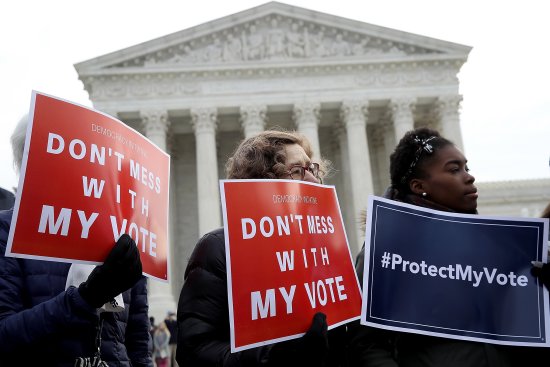
When the U.S. supreme court upheld Ohio’s method of cleaning up its voter rolls in a 5-4 decision on June 11, the ruling focused in large part on technical interpretations of federal voting law–but it also represented a broader debate about partisan visions of democracy.
The case centered on Larry Harmon, a software engineer who found he’d been taken off the voter-registration list when he showed up to cast a ballot in 2015. In Ohio, his home state, election officials can send residency-confirmation notices to anyone who skips one federal election cycle. If a voter fails to respond and doesn’t vote in the next four years, that person is purged from the rolls. Ohio sent Harmon such a notice, but he said he never got it. So, unable to vote, he went to court.
All states have systems for clearing registration lists of people who move away. The question here was whether failing to vote could trigger this process. Justice Samuel Alito wrote in his majority opinion that, even if Harmon never got the message, Ohio’s attempt to contact voters meant the state didn’t violate the National Voter Registration Act.
The case exposed a deep divide in how Americans interpret the idea of safeguarding the vote. Conservatives tend to argue that the vote needs to be protected from fraud, and call for more intensive scrutiny of voter rolls. (Many studies, including a 2014 report by the nonpartisan Government Accountability Office, have found no evidence of widespread voter fraud in the U.S.) Meanwhile, liberals say the ability to vote is what needs protecting–and that obstacles to doing so are meant to disenfranchise their constituencies, as tactics that make it harder to register disproportionately hurt poor and minority voters.
Harmon’s lawyers noted that 7,500 eligible Ohioans would have been unable to vote in the 2016 presidential election without an earlier decision in his favor. Ohio’s secretary of state said on June 12 that voters won’t be purged from the rolls before November’s midterms, but now that the Supreme Court overturned the previous ruling, voting-rights advocates fear the decision’s impact could spread beyond Ohio in future elections.
At least six other states have similar laws–although Ohio’s process moves quickest–and others are watching the case. “There’s a real risk that other secretaries of state will see this as an excuse to kick people off the voting rolls,” says Daniel Tokaji, a co-counsel on the lawsuit for Harmon and a voting-rights expert at Ohio State University.
Some advocates said the ruling presents a good opportunity to push for Election Day registration, which could provide a “fail-safe” if voters are accidentally purged. But until then, “some people are going to fall through the cracks,” says Lonna Atkeson, an expert on voting rights and election law at the University of New Mexico. “Those are going to be disproportionately Democratic voters.”